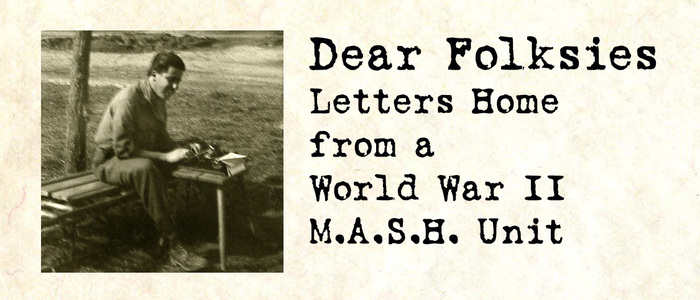May 31, 1944
While waiting for our equipment to catch up with us at Sessa, Chuck Schwartz and I took a side jaunt up toward the front as far as Formia and Gaeta. We rode along the Appian Way and witnessed nothing but destruction over every mile. The retreating Jerries had done a very thorough job of destroying every bridge and every foot of railroad. The rails were twisted and bent and even the ties were blown out of the roadbed.
Our engineers were doing a marvelous job of restoring the bridges and clearing the highway so that there remained very little obstruction to motor traffic. It was truly gratifying to see the equipment they used and the efficiency with which they operated it – huge bulldozers, scrapers, tractors, steam-shovels, cranes, portable sections for steel bridges. One realizes fully the tremendous problems of supply and engineer that go to make up an efficient war machine.
Most of the civilians in Gaeta were quite friendly, a reaction which we couldn’t quite understand or reconcile with the bombing and shelling which we presumed the allies must have administered to their town. Upon closer observation, however, we noticed that most of the destruction was confined to the street of houses adjoining the waterfront, and was far too uniform and complete to have been done by either shelling or bombing. The mystery was solved by one of the local civilians who explained that the ”Tedesci” had dynamited these buildings. The mass of plaster, steel and splintered building blocks formed an imposing defensive wall about 15 to 20 feet high and 20 feet long along almost the entire waterfront. Atop this wall the Germans had strung barbed wrie entanglements on which were hanging wooden signs: “Achtung! Attention! Mines!”
AMGOT (Allied Military Government of Occupied Territory) was already functioning in Gaeta. British officials were supervising the unloading of flour, canned milk and a few other food essentials from small fishing schooners tied up to the remaining wharves. Here and there carts piled high with freshly baked bread could be seen leaving a makeshift bakery or proceeding to the distribution points where long lines of men, women and children waited patiently for their ration. All was done quite orderly. The bread carts squeaked easily through the streets unmolested by the civilians, quite in contrast to the early days in Sicily. The people waiting in line seemed contented, chatting and smiling most of the time.
A large scraper operated by an American GI engineer was busily scraping the plaster and bricks from the streets and the men, women and children of the town were busy sweeping out their little homes and even the adjoining sidewalk and street – a thing unheard of in Sicily, and extremely gratifying to us as onlookers. We left Gaeta far more optimistic about post-war conditions in Italy than we ever dreamed of from our observations in Sicily.
.




